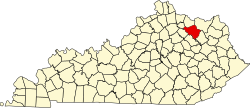Demographics
Historical population| Census | Pop. | Note | %± |
|---|
| 1800 | 5,016 | | — |
|---|
| 1810 | 8,947 | | 78.4% |
|---|
| 1820 | 12,186 | | 36.2% |
|---|
| 1830 | 13,499 | | 10.8% |
|---|
| 1840 | 13,268 | | −1.7% |
|---|
| 1850 | 13,914 | | 4.9% |
|---|
| 1860 | 12,489 | | −10.2% |
|---|
| 1870 | 13,398 | | 7.3% |
|---|
| 1880 | 15,221 | | 13.6% |
|---|
| 1890 | 16,078 | | 5.6% |
|---|
| 1900 | 17,074 | | 6.2% |
|---|
| 1910 | 16,066 | | −5.9% |
|---|
| 1920 | 15,614 | | −2.8% |
|---|
| 1930 | 12,931 | | −17.2% |
|---|
| 1940 | 13,327 | | 3.1% |
|---|
| 1950 | 11,962 | | −10.2% |
|---|
| 1960 | 10,890 | | −9.0% |
|---|
| 1970 | 11,366 | | 4.4% |
|---|
| 1980 | 12,323 | | 8.4% |
|---|
| 1990 | 12,292 | | −0.3% |
|---|
| 2000 | 13,792 | | 12.2% |
|---|
| 2010 | 14,348 | | 4.0% |
|---|
| 2020 | 15,082 | | 5.1% |
|---|
| 2024 (est.) | 15,591 | | 3.4% |
|---|
|
As of the census of 2000, there were 13,792 people, 5,367 households, and 3,966 families residing in the county. The population density was 39 people per square mile (15 people/km2). There were 6,120 housing units at an average density of 17 per square mile (6.6/km2). The racial makeup of the county was 97.33% White, 1.41% Black or African American, 0.14% Native American, 0.17% Asian, 0.28% from other races, and 0.67% from two or more races. 0.75% of the population were Hispanic or Latino of any race.
There were 5,367 households, out of which 34.80% had children under the age of 18 living with them, 60.30% were married couples living together, 9.60% had a female householder with no husband present, and 26.10% were non-families. 23.30% of all households were made up of individuals, and 11.00% had someone living alone who was 65 years of age or older. The average household size was 2.55 and the average family size was 2.99.
In the county, the population was spread out, with 25.40% under the age of 18, 8.40% from 18 to 24, 29.00% from 25 to 44, 23.90% from 45 to 64, and 13.40% who were 65 years of age or older. The median age was 36 years. For every 100 females there were 96.00 males. For every 100 females age 18 and over, there were 93.20 males.
The median income for a household in the county was $27,990, and the median income for a family was $33,300. Males had a median income of $26,463 versus $19,895 for females. The per capita income for the county was $14,214. About 14.80% of families and 18.60% of the population were below the poverty line, including 24.90% of those under age 18 and 20.10% of those age 65 or over.
This page is based on this
Wikipedia article Text is available under the
CC BY-SA 4.0 license; additional terms may apply.
Images, videos and audio are available under their respective licenses.



